Water Kefir Vs Milk Kefir, Using Traditional Grains
Kefirs are cultured drinks produced by lacto-fermenting certain liquids for a short 1-4 day period of time.
When
it comes to water kefir vs milk kefir, both can be health-enhancing
drinks to consume for most people. However, each variety of kefir is
made somewhat differently, utilizing unique cultures that provide
slightly different end results.
If you’re someone looking to
add kefir into your daily regimen, you may want to learn more about
these cultured drinks to see which one might be best for your current
health objectives.
The term “kefir” has several pronunciations depending on your country
of origin. Most people in the Western U.S. call it KEE-fir or sometimes
KEFF-er. The original Russian pronunciation however is KUH-fear.
On
this page, we are primarily discussing the difference between
traditional-style water kefir vs milk kefir when making homemade
artisanal varieties of this beverage. Both are made from SCOBY grains,
similar to how kombucha is fermented. The term SCOBY is short for Symbiotic Colony of Bacteria and Yeast, not to identify one particular ferment.
But,
before we discuss the top differences between water kefir vs milk
kefir, we’d first like to clarify the distinction between powdered kefir
starter cultures and commercial based kefir products.
Powdered Kefir Starter Cultures Vs Kefir Grains
The use of kefir grains, in both water and milk variations, is the traditional way to make milk kefir or types of water kefir, also commonly called “tibicos.”
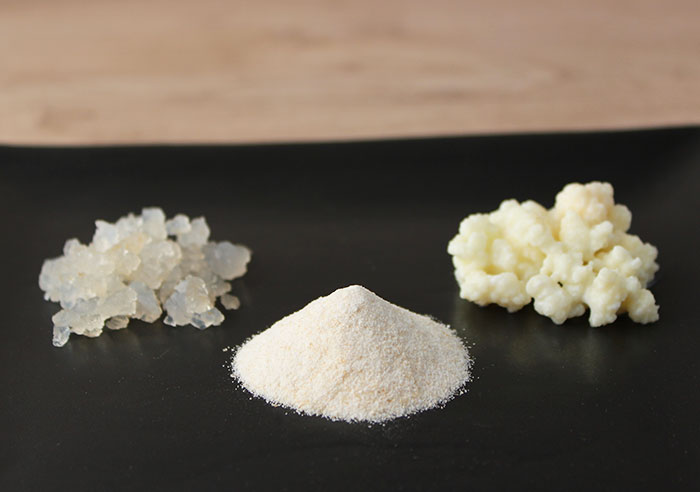
In recent times, especially is the last decade, kefir powdered starter cultures have become a popular way to make homemade kefir without having to use heirloom SCOBY grains. Although these types can be more convenient and used interchangeably between water kefir and milk kefir, they only contain SOME of the beneficial strains, not the diverse amount found in “true” grain-made kefir ferments.
While the kefir created from quality powdered starter cultures, like the one from Body Ecology, can be reused for a number of batches, eventually it will lose its ability to culture the liquid substrate.
By comparison, the grain cultures used to
make traditional-style kefir are actually referred to as a type of
“evolved life form” and a living matrix of microbes that, when properly
cared for, will proliferate and in-effect live indefinitely. So yeah,
they are a bit different!
Though powder-made varieties have
their place, for the serious kefir consumer, traditional-grain based
kefir can be a better, more cost-effective probiotic-diverse option to
powder starters.
What are Commercial Kefir Products Made From?
Kefir grains are considered “heirloom” forms and are more of an
artisan variety not used on a commercial scale as they are harder to
maintain and regulate for production purposes. Commercial kefir
products, both milk and water, are therefore most always made using
dried probiotic powder starters.
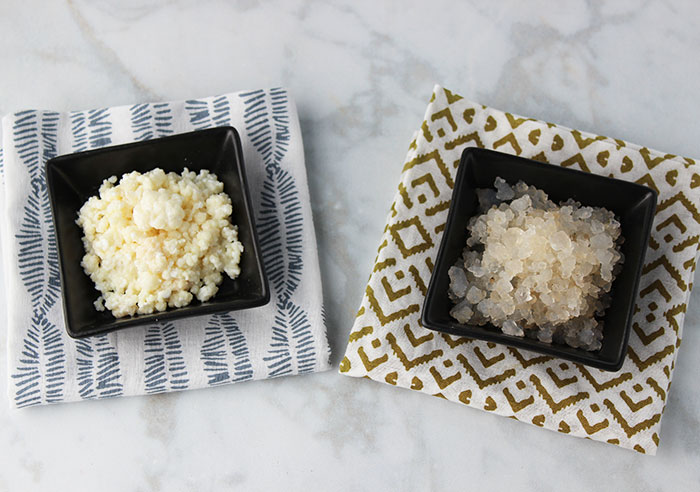
Top Differences Between Water Kefir Vs Milk Kefir
1) Water Kefir and Milk Kefir are Not Related Cultures
While both go by the name “kefir” and are cultured from SCOBY grains, the two are not actually directly related.
Milk kefir is believed to have its origins from the Caucasus mountain regions and has a long history of use in Russia, the countries Georgia and Turkey as well as other regions of Eurasia and Central Asia. Milk kefir grains themselves look a bit like small off-white cauliflower florets and have a dense rubbery texture. They vary in size but are generally larger than water kefir grains.
Water kefir or tibicos grains also vary in size but are nearly translucent, like tiny crystals, and tend to be smaller than milk grains. They also have an irregular less rounded shape in addition to a softer gummy texture.
2) They are Used to Culture Different Substrates
The obvious difference between water kefir vs milk kefir is that they
are used to culture different liquids. If you’ve ever tried to use
water kefir grains to ferment milk, you may have come to this
realization.
Milk kefir grains are used specifically to
culture milk. Traditionally, dairy milk is used but vegan milks can also
be substituted. A popular one we enjoy is coconut milk, made with the
flesh and water. To keep most milk kefir grains alive and thriving,
however, it is necessary to periodically use a dairy milk source. We
personally prefer using raw organic grass-fed cows milk over
pasteurized.
Water kefir is strictly used to ferment carbohydrate-rich sugary liquids, such as coconut water, fruit juice or water that has been mixed with a sugar source. The water used when making kefir works best in spring water or water that has minerals added.
Typically, 2 Tablespoons of water grains and 1 Tablespoon of milk kefir grains are used for about one quart of liquid.
3) Contain Different Strains of Lactic Acid Bacteria and Yeast
The visual distinctions between the two grains are of course
associated with the different blend of yeast and bacterial microbes they
are made of, probiotics that will further inoculate into the fermented
liquids.
Both milk and water varieties are considered “wild”
cultures, in that they can take on other species over time. Grains may
therefore vary from one to the next in overall composition. To keep your
homemade ferment free of other species, you can use an air-lock cap as
kefir’s don’t require oxygen to ferment.
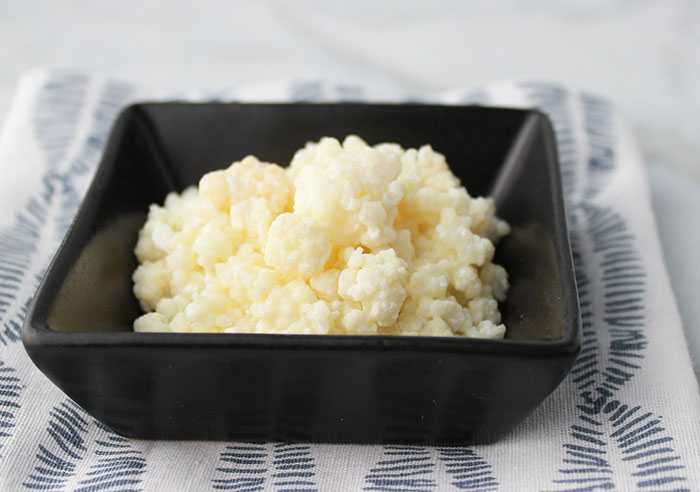
Milk Kefir Bacteria and Yeast Strains
Generally speaking, milk kefir grains are known to contain larger ratios
of the Lactobacillus species than water grains. Here are some species found in milk kefir
grains. (Source)
4) Health Benefits of Water Kefir Vs Milk Kefi
Both water-based and milk-based kefir varieties are probiotic-rich drinks that help to colonize the intestinal tract and have a health-enhancing impact on maintaining balanced gut flora. (*)
This is a topic which is receiving a lot of attention these days and with good reason. Gastrointestinal microbiota that live in the human digestive tract are a “complex community of microorganisms” that when in proper ratio are known to have a huge influence on our human physiology and overall long-term well-being.
The good news is that these “pro-life” gut flora can be nourished through dietary sources. It is often recommended to include a diverse variety of fermented foods in the diet to get a good cross section of different mircroflora, especially after a period of antibiotic use.
This may include periodic probiotic supplementation, however cultured food and drinks tend to be better overall sources. This is because they are “enzymatically” active and are also, according to a Body Ecology article, resistant to harsh stomach acid. (*)
Some
health experts also believe that consuming ferments like water and milk
kefir, with probiotic supplements helps to aid in their assimilation.
We use the powder from probiotic capsules when making cultured
vegetables, like kimchi, as well as cultured seed cheeses.
When comparing the beneficial properties of water kefir vs milk kefir, milk kefir can offer a significantly higher number of probiotic strains than water-based kefirs. The average amount for milk kefir is between 30-50 as opposed to about 10-15 from the tibicos varieties. Water kefir however is identified to contain more strains than that of cultured yogurt and kefir made from powder starters.
Both types of cultured kefir are known to be well tolerated in contrast to other ferments. They can be a more suitable option for those with digestive sensitivities who might not be able to handle other cultured foods like sauerkraut, rejuvelac or kombucha.
Generally, milk kefir is better for those recovering from a candida infection, whereas water kefir may potentially contain sugar content if not completely fermented.
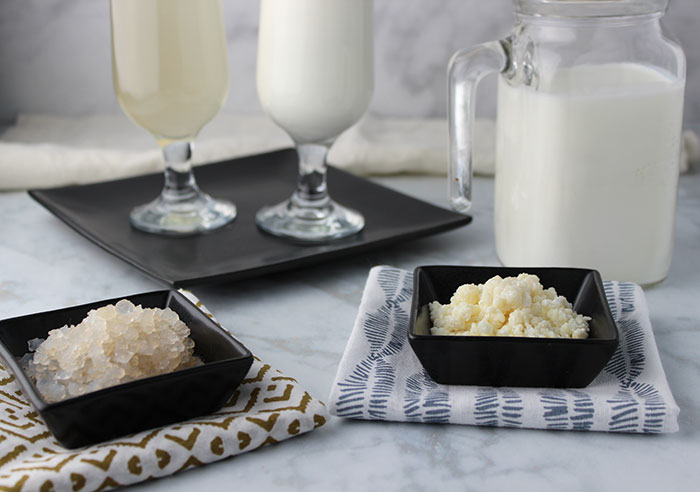
5) Quality of Taste and Texture
The taste and textural qualities of water kefir vs milk kefir are quite different in our opinion.
Milk
kefir has a very thick creamy consistency and with a tart sour taste
similar to yogurt. It is not sweet but can have a mild effervescence.
Milk-based
kefirs get there notably thick characteristic from a substance known as
kefiran, a water-soluble polysaccharide that congeals with other
species during fermentation, gelatinizing the liquid and creating a
creamy texture.
Water kefir is usually sweet with a slight
tang and fizziness. Taste can vary however depending on fermentation
time and ingredients used. Sometimes different combinations of sugars
and fruits are also incorporated. Final ferments can have a slightly
thicker quality with some cloudiness.
These two types of
kefirs of course can be flavored with natural sweeteners or blended with
fruits like berries or even various herbal spices if desired.
Traditional-Style Water Kefir Vs Milk Kefir List
WATER KEFIR
- A vegan dairy-free option
- Takes about 48 hours at between 68-85°F (20-29°C)
- Provides a soda-like alternative
- More probiotic strains than yogurt or powdered starters
- May contain sugar depending on fermentation time
- No fat content, lower in calories
MILK KEFIR
- Contains bioavailable vitamins, minerals and amino acids
- Takes about 24 hours 72-75°F (22-24°C)
- Provides a thick creamy probiotic-rich drink
- Does not contain sugar, but is higher in calories
- Culturing process can potentially reduce lactose in dairy milk
- Easier to ferment, less finicky
6) Other Misc Differences Between Water Kefir Vs Milk Kefir
Water Kefir Makes a Great Low Calorie Soda Alternative
Water kefir is a probiotic-rich beverage that also makes a great alternative to sodas. It can be fermented to produce different levels of fizziness similar to carbonated soft drinks.
For those looking for a dairy-free replacement to cow or
goat milk
kefirs, water kefir can be an excellent choice. Water kefirs are
additionally lower in calories in contrast to kefir made from dairy
milk, nut milks and soy milk. They can be a better choice for those
looking to reduce body weight and daily caloric intake.
Milk Kefir Contains More Nutrients
Both dairy milk and vegan milk sources also come with their list of vitamins, minerals and amino acids. The process of lacto-fermenting them with kefir grains, additionally makes these nutrients more bioavailable as they are in essence “pre-digested.”
Dairy milk, from cows, goat or other animals, is identified to be a good dietary source of certain bone building minerals like calcium. Cultured milk kefir is therefore known to enhance calcium absorption, and in some research short-term use was associated with an increase in hip bone mineral density in patients with osteoporosis.
Kefir
fermentation is also known to reduce the lactose content in milk, since
that’s what the grains feed off of. It has thus been purposed to be
more suitable for those with lactose intolerance. (*)
Milk Kefir Tends to Be Easier to Ferment
When making both types of homemade kefir from SCOBY grains, we have personally experienced that milk-based kefir tends to be less finicky about maintaining a consistent temperature and is relatively easier to culture than kefir made from sugar water.
How to Use
Milk or water-based kefir, in our opinion, works best as a “probiotic
supplement” when consumed first thing in the morning or 2-3 hours
before or after meals. We recommend consuming it in small shot glass
size amounts if you’re new to drinking it, then eventually increase
amount.
Both varieties, however, can also be added to blended drinks and protein shakes mixed with other superfoods or ingredients.
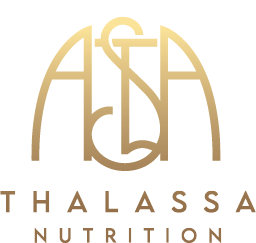
 no
no no
no no
no